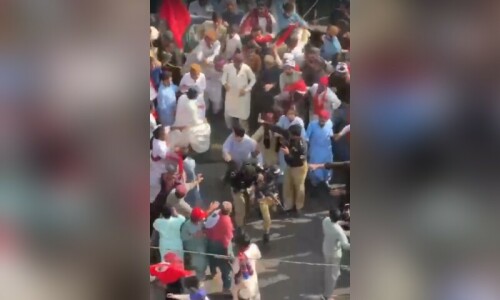TRAGEDIES invite attention to the human follies which led to them. On Feb 3, an avalanche hurtled down the Siachen glacier wiping out an Indian military post and killing 10 Indian soldiers. In its wake not a few urged the settlement of the Siachen dispute with Pakistan.
Similar pleas were heard in Pakistan a few years ago when an avalanche exacted a toll of human lives on Pakistan’s side.
However, India’s Defence Minister Manohar Parrikar said that India would not vacate Siachen. “If we vacate the position, the enemy can occupy the position and they would have the strategic advantage. Then we will have to lose many more lives. We know the experience of 1984. I know we have to pay the price and I salute our armed forces personnel, but we have to maintain this position. ... The position is very important from the strategic point.”
Avalanches and deaths have failed to move the politicians.
The record establishes that the ground of distrust he cited is groundless as, indeed, is the oft-cited demand for authentication of the existing position held by Pakistan. That is marked by two aborted agreements, fitful efforts to renew them and declarations of resolve to stay put even if the concerns on those two points, are met; as, indeed, they were in the two accords.
In June 1989, after talks between the defence secretaries of India and Pakistan, a joint statement was issued. It said: “There was agreement by both sides ... on redeployment of forces ... the future positions on the ground so as to conform with the Shimla Agreement … the army authorities of both sides will determine these positions.”
Pakistan’s foreign secretary at the time said the accord envisaged relocation of forces “to positions occupied at the time of the Shimla agreement”. India’s foreign secretary stated he would “endorse everything” his Pakistani counterpart said. India’s army chief wanted the existing positions identified. There was an attempt during prime minister Rajiv Gandhi’s Pakistan visit in 1989, to break the impasse by extending the LoC northwards, India’s offer was that the line “should run due north, that is, up to the Chinese border in a ruler-straight line,” dividing the zone between the two countries. Nothing came of it.
Pakistan claimed the area from NJ9842, where the LoC ended, to the Karakoram Pass in the east; India from that point to Indira Col in the west which it had occupied in 1984.
There was a breakthrough in talks in New Delhi in November 1992. The drafts of both sides spelt a deadlock. To resolve it, Pakistan presented an amendment which conceded authentication of the existing positions. It read thus: “The armed forces of the two sides shall vacate areas and redeploy as indicated in the annexure. The positions vacated would not, for either side, constitute a basis for a legal claim or justify a political or moral right to the area indicated. The delineation of the Line of Control from point NJ9842 to the Karakoram Pass will form part of the comprehensive settlement to follow the redeployment of troops.” Pakistan dropped its reference to the pass later.
The Hindu published the full texts of the drafts as also an interview by N.N. Vohra, now governor of Indian Kashmir, who led the Indian delegation. He revealed: “We had finalised the text of an agreement at Hyderabad House by around 10pm on the last day. Signing was set for 10am. But later that night, instructions were given to me not to go ahead the next day but to conclude matters in our next round of talks in Islamabad in January 1993. That day never came.”
In a non-paper India gave Pakistan in January 1994, it accepted that in 1992 “on Siachen a broad understanding had been reached on disengagement and redeployment, monitoring, maintenance of peace and implementation schedule”. Nothing was left out from the elements of the accord which it spelt out. It included disengagement “from authenticated positions”. If either side violated the terms the other would be “free to respond through any means, including military”. Thus the excuses, authentication and distrust, are groundless.
In July 1998, then defence minister George Fernandes wiped out the agreed basis for talks since 1986 — mutual withdrawal. He said: “India needs to hold on to Siachen both for strategic reasons and wider security in the region” (read: border with China).
It had been agreed that India would withdraw to Dzingrulma and Pakistan to Goma and surveillance of the area was to be by helicopter. Prime minister Manmohan Singh spoke of the ‘mountain of peace’ when he visited Siachen in 2005. The then army chief mounted a campaign against it. He demanded authentication and monitoring, both of which were settled in November 1992. Most Indian experts agree that a settlement is in India’s interests.
The writer is an author and a lawyer based in Mumbai.
Published in Dawn, March 26th, 2016












































